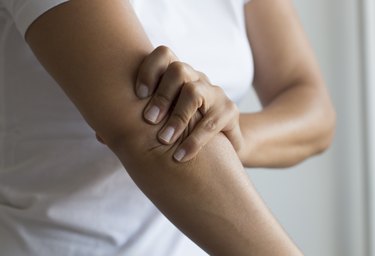
Arm wrestling can produce arm injuries similar to trying to lift too much weight at the gym. Muscles, tendons and ligaments in your shoulder, arm and elbow are especially at risk of injury. Seek medical attention if you suspect a severe injury. Your doctor may take X-rays to check for bone injuries or request magnetic resonance imaging to examine the extent of the injury.
Read more: Arm Wrestling & Elbow Pain
Video of the Day
Video of the Day
Arm Wrestling Injuries
Strains and sprains are minor arm wrestling injuries that may produce pain after this activity. Strains involve stretched or torn muscle fibers or tendons, and sprains involve torn or stretched ligaments.
Grade 1 injuries involve the least torn or stretched tissue, slight pain, slightly warm skin and little or no skin redness. Grade 2 injuries involve torn tissue and more pain, particularly when stretching or contacting the muscle. Muscles in your arm may feel swollen, and warm or hot to the touch. Pain and other symptoms for these injuries may last 24 to 72 hours.
Severe Strains and Sprains
Grade 3 strains and sprains occur when you tear most of the fibers in a muscle or most of the ligament tissue in your joints. These severe injuries produce immediate and extreme pain. You may also experience prolonged heating of the skin, redness and swelling. The contour of your muscle may visibly change as a result of severe tissue damage. These injuries may completely eliminate or severely reduce muscle functioning in your arm.
Treatment for Strains and Sprains
Addressing strain and sprain injuries immediately can prevent arm wrestling injuries from worsening. Use the RICE method — rest, ice, compression and elevation, as recommended by Mayo Clinic. Let tissues in your arm begin healing by keeping weight off your arm.
Applying ice for 15 to 30 minutes every two hours can reduce pain, redness and swelling. Gentle pressure with elastic bandages for 30 minutes can slow internal bleeding and swelling. Elevating your arm 6 to 12 inches above your heart reduces blood flow and any internal bleeding.
Severe injuries may require immobilization with a brace or splint. Your doctor may suggest surgery as a last resort for especially severe strains and sprains.
Chance of Bone Fracture
Fracture of the humeral shaft bone may be the most common injury reported in arm wrestling, according to a research review published in 2018 in the Manual Therapy, Posturology & Rehabilitation Journal. These fractures typically affect the lower part of the upper arm bone and most often occur in a spiral pattern from the torquing that occurs during arm wrestling.
Fractures cause severe arm pain and immediate loss of grip strength. You may see changes in the contour of your arm if you have a complete fracture. Your arm may feel tender to the touch, and you may experience coldness in your arms or hands if blood supply is impaired.
Fractures require immediate medical attention. Your doctor may be able to realign the broken bones without surgery, or she may apply nails and pins during surgery to hold bone fragments together.
Read more: Arm Wrestling Rules & Regulations
- SportsInjuryClinic.net: Medial Elbow Ligament Sprain
- Manual Therapy, Posturology & Rehabilitation Journal: Arm-Wrestling Injuries — A Systematic Review of the Medical Literature
- Mayo Clinic: Muscle Strains: Overview
- Mayo Clinic: Muscle Strains: Diagnosis & Treatment
- Hospital for Special Surgery: Muscle Injuries: An Overview
Is this an emergency? If you are experiencing serious medical symptoms, please see the National Library of Medicine’s list of signs you need emergency medical attention or call 911.